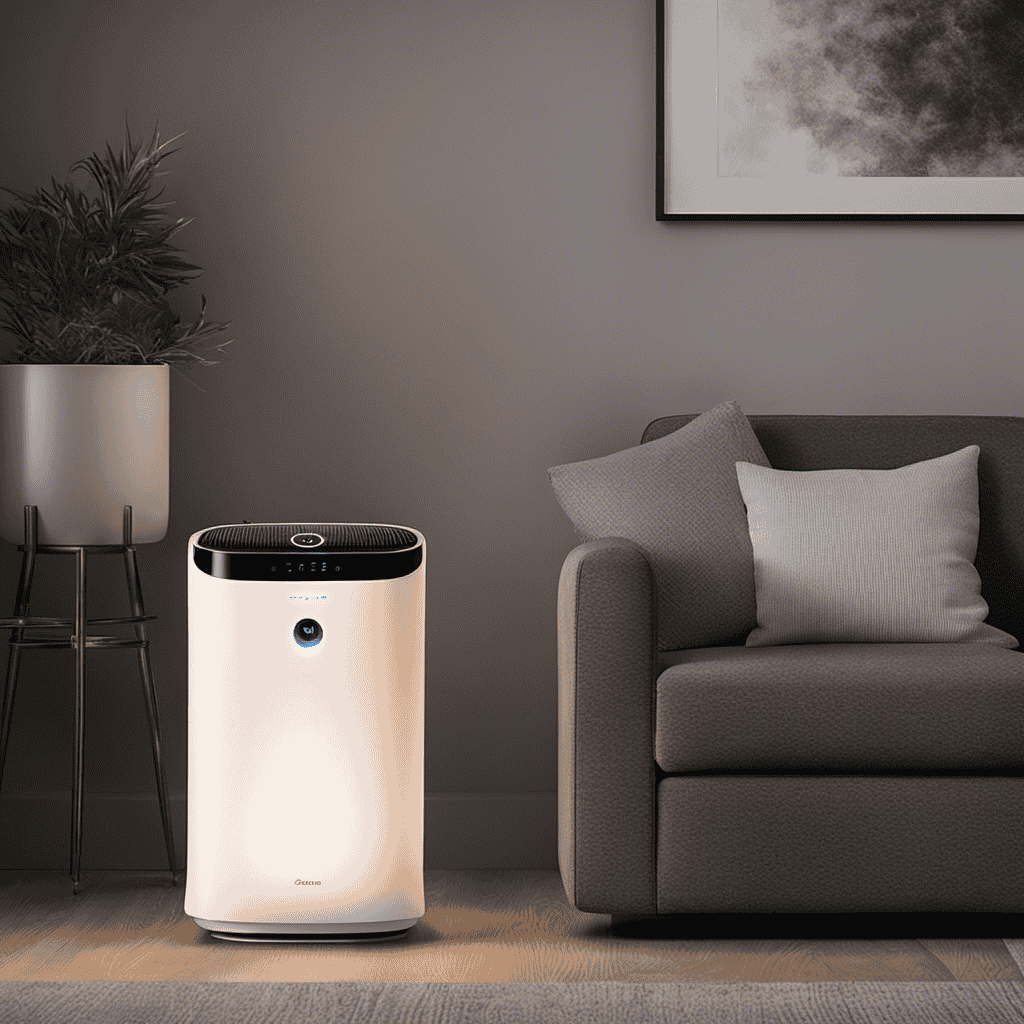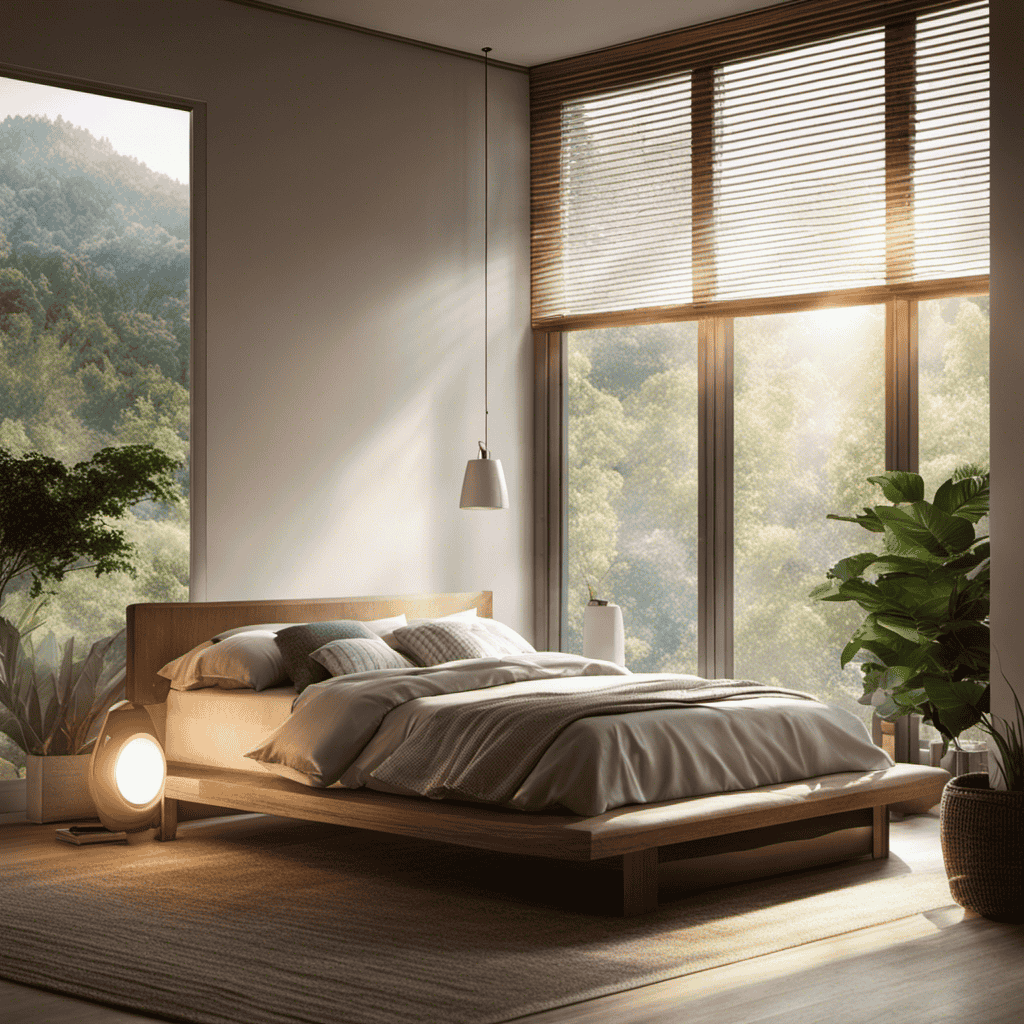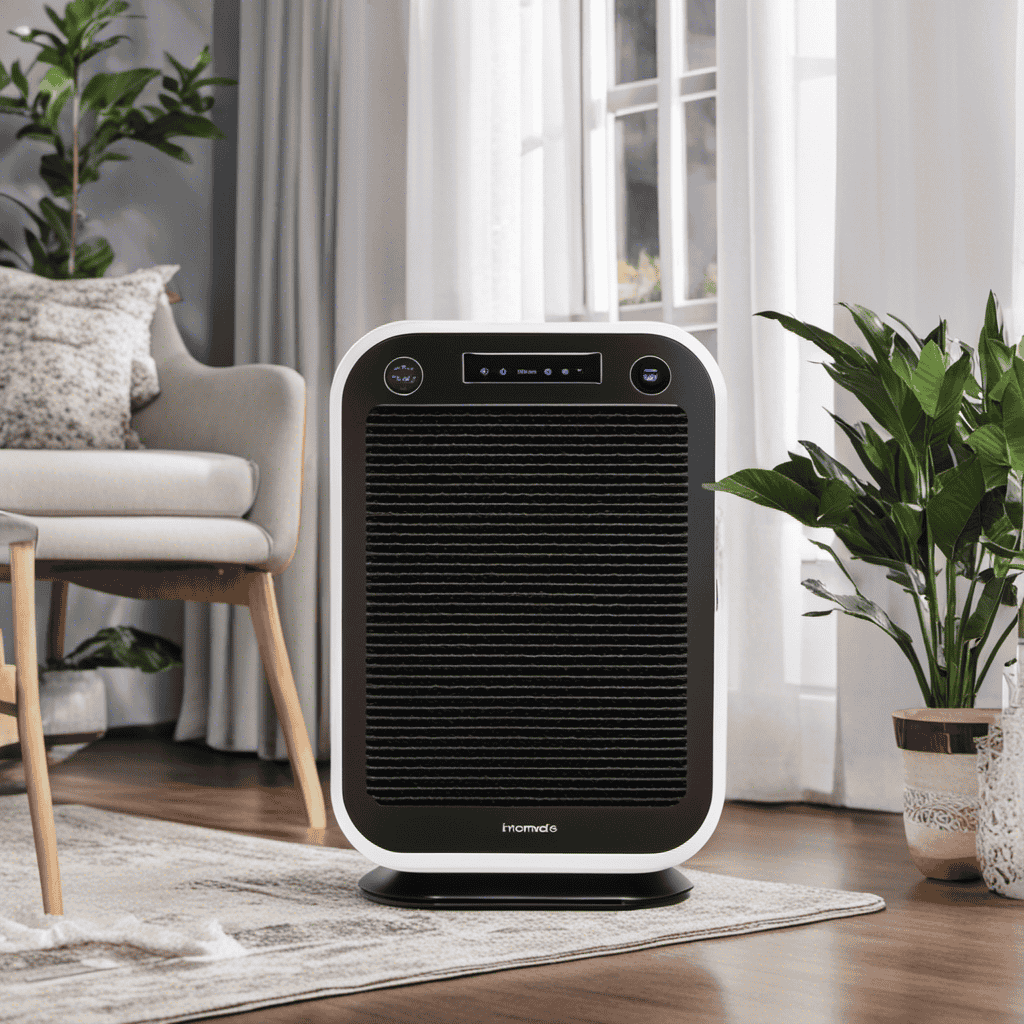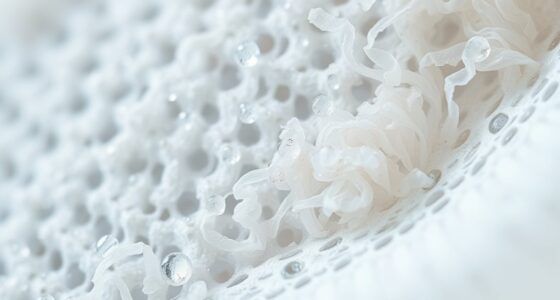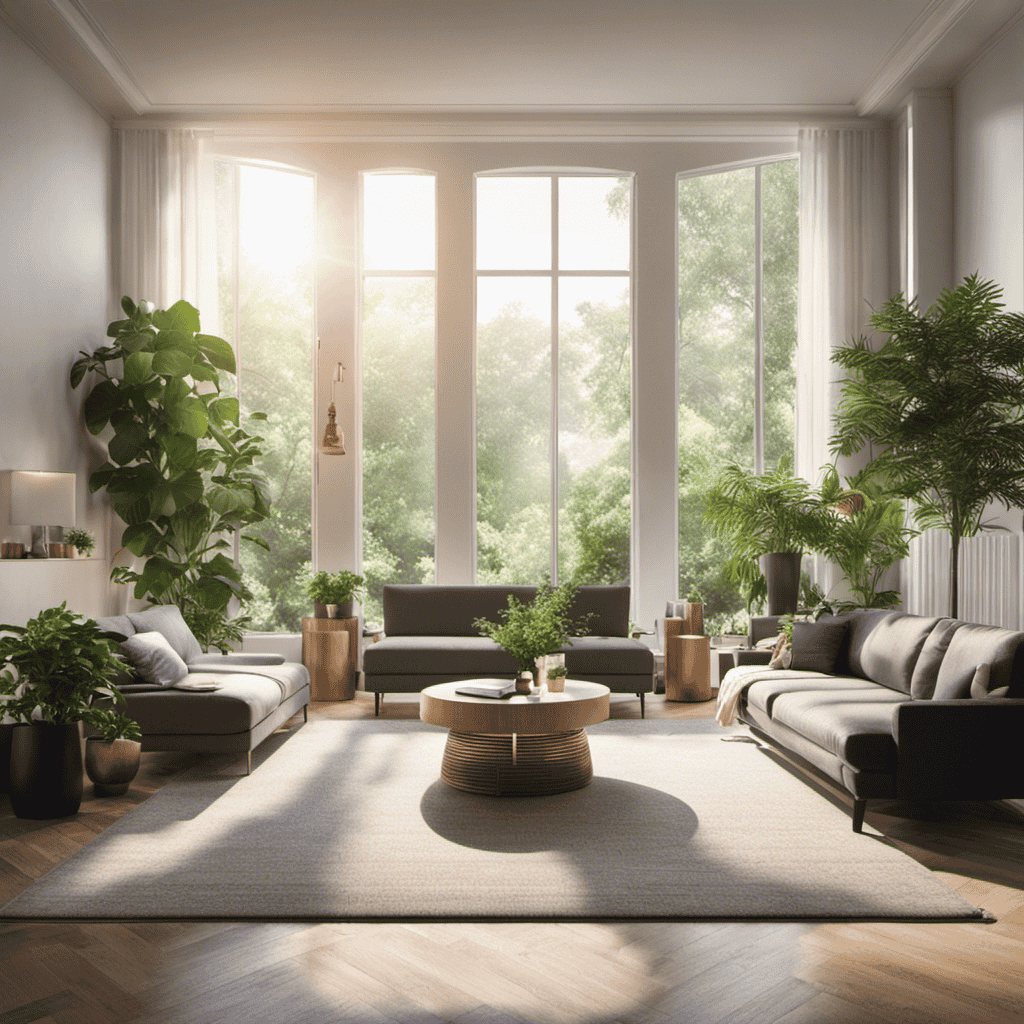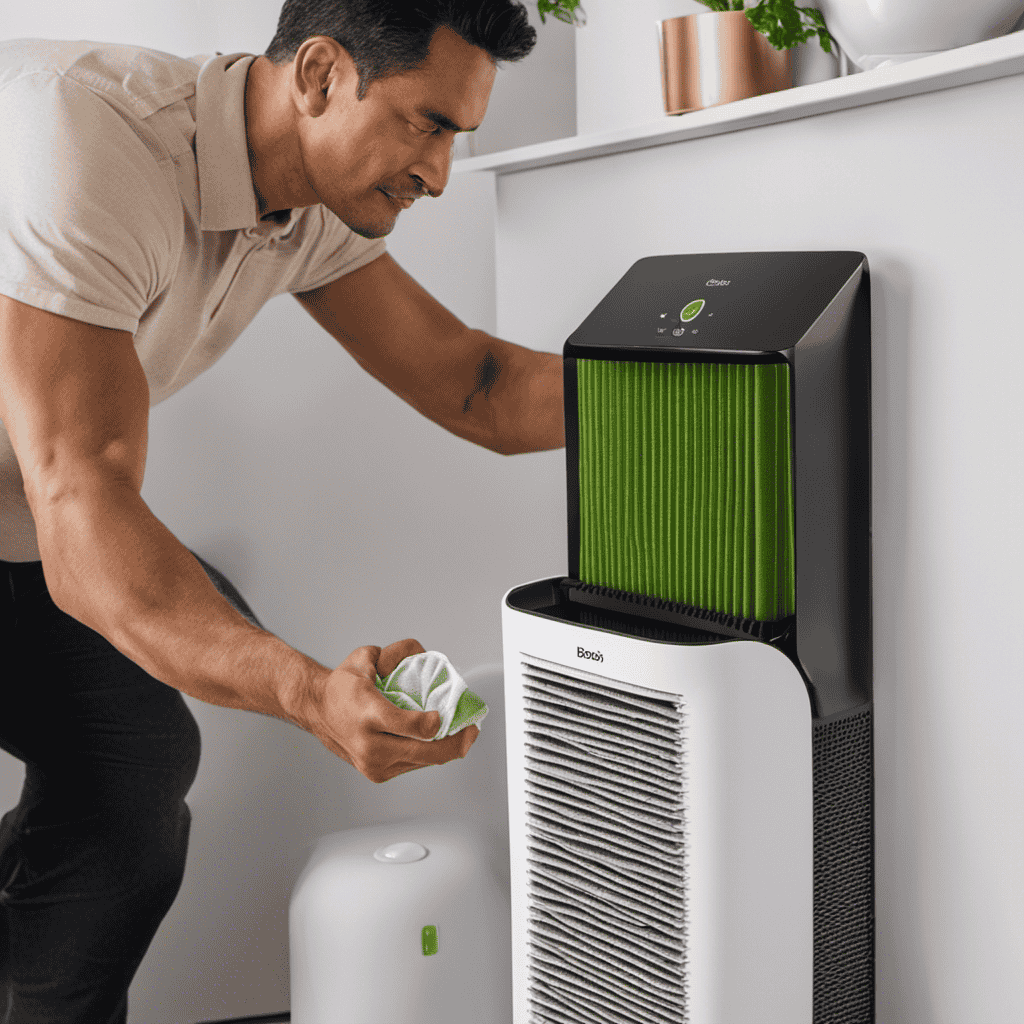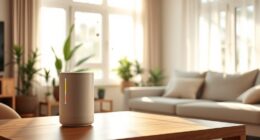While lounging in my house, enjoying its cozy ambiance and feeling secure, I find myself questioning the effectiveness of my air purifier. Is it successfully removing hazardous pollutants from the air I inhale?
In this article, we will delve into the importance of air purification, understanding air quality, and the factors to consider when assessing air purifier performance. Together, we will explore the signs of an effective air purifier, common mistakes to avoid, and tips for maximizing its efficiency.
Let’s embark on this journey to ensure the air we breathe is truly clean and pure.
Key Takeaways
- Regular maintenance, including cleaning or replacing filters, is essential for the efficiency and lifespan of air purifiers.
- Monitoring air pollution with indoor air quality sensors helps determine the effectiveness of the air purifier.
- Factors like CADR rating, filter size, and type determine the effectiveness of air purifiers in removing airborne pollutants.
- Effective air purifiers reduce allergy symptoms, remove pollutants, contribute to decreased dust accumulation, and improve respiratory health.
Importance of Air Purification
Air purifiers are essential for improving indoor air quality. They play a crucial role in removing harmful pollutants and allergens from the air, ensuring that we breathe clean and healthy air. The benefits of air purification are numerous.
Firstly, it helps to reduce the risk of respiratory illnesses such as asthma and allergies by removing airborne irritants like dust, pollen, and pet dander. Additionally, air purifiers can eliminate harmful volatile organic compounds (VOCs) and odors, creating a more pleasant and fresh-smelling environment.
To ensure that your air purifier continues to provide these benefits, regular maintenance is necessary. This includes cleaning or replacing the filters as recommended by the manufacturer. Filters are designed to capture pollutants, but over time they can become clogged and less effective. It is also important to clean the unit itself, as dust and debris can accumulate on the surface and hinder its performance. By following the maintenance guidelines, you can maximize the efficiency and lifespan of your air purifier.
Understanding air quality is essential in determining if your air purifier is doing its job effectively. In the next section, we will explore the key indicators of air quality and how to assess them accurately.
Understanding Air Quality
When it comes to air purifiers, it’s crucial to understand their effectiveness in improving indoor air quality.
Monitoring air pollution is an essential aspect of ensuring the efficiency of air purifiers.
In this discussion, we’ll explore the factors that determine the effectiveness of air purifiers and the methods available for monitoring air pollution.
Air Purifier Effectiveness
I’m not sure if my air purifier is working properly. It seems to be running, but I’m not sure if it’s actually doing its job. To determine its effectiveness, there are a few factors to consider:
-
Air quality improvement: Monitor the air quality in your home before and after using the purifier. Look for a decrease in allergens, dust, and other pollutants.
-
Maintenance: Regularly clean or replace the filters as recommended by the manufacturer. A clogged filter can hinder the purifier’s performance.
-
Noise levels: While some noise is expected, excessive or unusual noise could indicate a problem. Check for loose parts or debris that may be causing the noise.
-
Odor reduction: An effective purifier should also reduce unpleasant odors in your home. If you notice persistent odors, it may be a sign that the purifier is not working properly.
Monitoring Air Pollution
By regularly checking the air quality in your home, you can monitor the effectiveness of your air purifier. One way to do this is by using air pollution monitoring technologies, such as indoor air quality sensors. These sensors can measure various pollutants present in the air, including particulate matter, volatile organic compounds (VOCs), and carbon dioxide levels. By tracking these pollutants over time, you can determine if your air purifier is adequately reducing the levels of contaminants in your home. To make it easier for you to understand, here’s a table showcasing the different types of air pollution monitoring technologies and the pollutants they measure:
| Technology | Pollutants Measured |
|---|---|
| Particulate Matter Sensors | PM2.5, PM10 |
| VOC Sensors | Formaldehyde, Benzene |
| Carbon Dioxide Sensors | CO2 |
| Gas Sensors | Nitrogen Dioxide, Ozone |
Using these technologies, you can ensure that your air purifier is effectively improving the air quality in your home.
Factors to Consider When Assessing Air Purifier Performance
To determine if your air purifier is doing its job, you should consider factors such as the CADR rating and the size and type of filter it uses. These factors play a crucial role in determining the effectiveness of your air purifier in removing airborne pollutants.
Here are four key factors to consider when assessing air purifier performance:
-
CADR Rating: The Clean Air Delivery Rate (CADR) measures the purifier’s ability to remove specific pollutants such as smoke, pollen, and dust. A higher CADR rating indicates a faster and more efficient purification process.
-
Filter Size: The size of the filter affects its capacity to capture and trap pollutants. A larger filter can handle a higher volume of air, making it more effective in purifying the environment.
-
Filter Type: Different filters target specific pollutants. HEPA filters, for example, are highly effective in removing allergens and fine particles, while activated carbon filters excel at eliminating odors and volatile organic compounds (VOCs).
-
Maintenance and Replacement: Regular maintenance and timely filter replacement are vital to ensure optimal performance. Clogged or dirty filters can hinder airflow and reduce the purifier’s efficiency.
Signs That Your Air Purifier Is Effective
As someone who suffers from allergies, I have always been on the lookout for ways to reduce my symptoms. One key benefit of an effective air purifier is the reduction of allergy symptoms.
Research has shown that a high-quality air purifier can remove allergens such as pollen, pet dander, and dust mites from indoor air, leading to fewer allergy triggers. Additionally, an effective air purifier can help maintain cleaner indoor air by removing pollutants such as smoke, odors, and volatile organic compounds (VOCs), improving overall indoor air quality.
Furthermore, a well-functioning air purifier can also contribute to decreased dust accumulation in the home, as it captures and traps airborne dust particles, preventing them from settling on surfaces. This can lead to a cleaner and healthier living environment.
Reduced Allergy Symptoms
You’ll notice fewer allergy symptoms if your air purifier is doing its job. Here are four key ways in which an effective air purifier can improve respiratory health and reduce asthma symptoms:
-
Removal of allergens: A high-quality air purifier can effectively capture and remove common allergens such as pollen, dust mites, pet dander, and mold spores from the air, reducing their presence and minimizing allergic reactions.
-
Filtering out pollutants: Air purifiers with HEPA filters can eliminate harmful pollutants like smoke, volatile organic compounds (VOCs), and fine particles, which can trigger asthma symptoms and respiratory issues.
-
Improved indoor air quality: By continuously circulating and filtering the air, an air purifier helps maintain a cleaner and healthier indoor environment, reducing the overall allergen load and improving respiratory health.
-
Enhanced sleep quality: With cleaner air, individuals with allergies or asthma can experience fewer nighttime symptoms, leading to better sleep quality and overall well-being.
With reduced allergy symptoms and improved respiratory health, the next section will discuss the importance of cleaner indoor air for overall wellness.
Cleaner Indoor Air
Breathe easier and feel healthier with cleaner indoor air. Maintaining the quality of the air we breathe is crucial for our overall well-being. Regular air purifier maintenance and choosing the right air purifier are key factors in ensuring cleaner indoor air. Here is a table that outlines the steps for air purifier maintenance and provides tips for selecting the right air purifier:
| Air Purifier Maintenance | Choosing the Right Air Purifier |
|---|---|
| Clean the filters regularly | Consider the size of the room |
| Replace filters as recommended | Look for HEPA filters |
| Keep the air purifier in a suitable location | Consider noise levels |
| Check the airflow and adjust settings accordingly | Look for additional features like an ionizer |
| Monitor the air quality with a built-in sensor | Consider energy efficiency |
Decreased Dust Accumulation
After learning about the benefits of cleaner indoor air, let’s now focus on another positive outcome of having an effective air purifier: decreased dust accumulation.
As someone who suffers from allergies, I know how irritating it can be to constantly dust and clean my home. But with an air purifier that is doing its job, I have noticed a significant reduction in the amount of dust settling on surfaces. This is not only visually pleasing but also contributes to improved respiratory health.
To ensure that your air purifier continues to perform optimally, it is crucial to regularly maintain it. Here are four maintenance tasks you should prioritize:
- Cleaning or replacing the filters as recommended by the manufacturer.
- Vacuuming the pre-filter to remove larger particles.
- Wiping down the exterior of the purifier to remove dust and dirt.
- Checking the fan and motor for any signs of damage or malfunction.
Common Mistakes to Avoid When Using an Air Purifier
One common mistake to avoid when using an air purifier is forgetting to regularly clean or replace the filters. Filters are an essential component of an air purifier, as they trap and remove pollutants from the air. Over time, these filters can become clogged with dirt, dust, and other particles, reducing the efficiency of the purifier. To ensure optimal performance, it is important to follow the manufacturer’s instructions and clean or replace the filters as recommended.
In addition to maintaining the filters, there are other common mistakes that users should avoid when using an air purifier. These include placing the purifier in an ineffective location, neglecting proper ventilation, and ignoring the noise levels of the device. By avoiding these mistakes, you can maximize the benefits of using an air purifier in the bedroom.
Here is a table that summarizes the common mistakes to avoid when using an air purifier:
| Mistake | Description |
|---|---|
| Forgetting to clean filters | Dirty filters reduce the efficiency of the air purifier. |
| Placing the purifier incorrectly | Proper placement ensures effective air circulation and purification. |
| Neglecting proper ventilation | Good ventilation helps in maintaining air quality and freshness. |
| Ignoring noise levels | Noisy air purifiers can disturb sleep and cause discomfort. |
Tips for Maximizing the Efficiency of Your Air Purifier
To get the most out of your air purifier, make sure to regularly clean or replace the filters and place it in an effective location with proper ventilation. Maximizing airflow and ensuring proper filter maintenance are crucial in maximizing the efficiency of your air purifier. Here are some tips to help you achieve that:
-
Clean or replace filters regularly: Filters are the heart of an air purifier. Over time, they can become clogged with dust, pollen, and other pollutants, reducing their effectiveness. Regularly cleaning or replacing the filters ensures that your air purifier can continue to remove airborne contaminants efficiently.
-
Maintain proper ventilation: Proper airflow is essential for the optimal functioning of an air purifier. Ensure that the unit is not obstructed by furniture or other objects, as this can impede the flow of air. Additionally, placing the air purifier near a doorway or window can help facilitate the circulation of clean air throughout the room.
-
Avoid placing the air purifier in corners: Corners can restrict the airflow and limit the coverage area of your air purifier. Instead, position it in the center of the room or near areas where air pollutants are most prevalent.
-
Consider the size of the room: Air purifiers come in different sizes, and it’s important to choose one that is appropriate for the room you intend to use it in. A unit that is too small may not effectively clean the air, while one that is too large may consume unnecessary energy. Consult the manufacturer’s guidelines to determine the suitable size for your room.
When to Replace or Upgrade Your Air Purifier
If you’re unsure whether it’s time to replace or upgrade your air purifier, take into consideration the age of your current unit and any noticeable decrease in its performance. Air purifiers are designed to remove pollutants and improve indoor air quality, but over time, their effectiveness can diminish. Regular maintenance can help prolong the lifespan of your air purifier, but eventually, it may be necessary to replace or upgrade your unit.
Here are a few factors to consider when deciding whether to replace or upgrade your air purifier:
| Factors to Consider | Replace | Upgrade |
|---|---|---|
| Age of the unit | Over 5 years | Over 8 years |
| Performance | Significant decrease in air purification efficiency | Moderate decrease in air purification efficiency |
| Filter replacement | Costly or difficult to find replacement filters | Compatible with newer, more efficient filters |
| Technological advancements | Outdated technology | New features and improved performance |
If your air purifier is more than 5 years old and shows a significant decrease in performance, it may be time to replace it. However, if your unit is still relatively new but you notice a moderate decrease in its efficiency, upgrading to a newer model with advanced features may be a better option. Regular air purifier maintenance, such as cleaning or replacing filters, can also help extend the lifespan of your unit. Remember to consult the manufacturer’s guidelines for specific recommendations on when to replace or upgrade your air purifier.
Frequently Asked Questions
How Often Should I Clean or Replace the Filters in My Air Purifier?
I clean the filters in my air purifier every three to six months, depending on the manufacturer’s recommendations. Regular cleaning helps maintain the efficiency of my air purifier by removing dust, allergens, and other particles that accumulate on the filters over time.
As for replacing the filters, I typically do so every six to twelve months, again following the manufacturer’s guidelines. This ensures that my air purifier continues to effectively clean the air in my space.
Can an Air Purifier Eliminate All Types of Indoor Pollutants?
When it comes to air purifiers, it’s important to understand their limitations. While they can effectively remove many indoor pollutants, they may not eliminate all types.
Some pollutants, like certain gases and volatile organic compounds, may require specialized filters or technologies. It’s crucial to research and choose an air purifier that suits your specific needs.
Regular maintenance and filter replacements are also key to ensure the effectiveness of your air purifier in improving indoor air quality.
Can an Air Purifier Help With Allergies and Asthma Symptoms?
An air purifier can be effective in reducing allergens and asthma triggers in indoor environments. It filters the air, capturing particles such as dust, pollen, pet dander, and mold spores. By removing these irritants, air purifiers can help alleviate allergy and asthma symptoms.
However, it is important to choose the right type of air purifier and ensure it is properly maintained for optimal effectiveness. Regular cleaning and filter replacements are necessary to reap the full benefits of air purifiers.
Can I Run My Air Purifier All Day, or Should I Only Use It in Certain Rooms?
I always wonder if it’s better to run my air purifier all day or just in certain rooms.
Well, let me tell you, running your air purifier continuously can have some great benefits. It helps to constantly filter out pollutants, allergens, and odors, ensuring clean and fresh air throughout your home.
Additionally, using your air purifier in different rooms allows for targeted purification, addressing specific needs in each area.
Are There Any Potential Health Risks or Side Effects Associated With Using an Air Purifier?
Potential health risks or side effects associated with using an air purifier are a concern for many. It is important to thoroughly evaluate the effectiveness of these devices.
Evaluating factors such as the air quality improvement, reduction in allergens, and overall respiratory health can help determine if the air purifier is doing its job. However, it is always recommended to follow manufacturer guidelines and ensure proper maintenance to minimize any potential risks or side effects.
Conclusion
In conclusion, assessing the effectiveness of your air purifier is crucial for ensuring the quality of the air you breathe. By understanding the factors that contribute to air purification, avoiding common mistakes, and maximizing the efficiency of your device, you can create a cleaner and healthier environment.
Remember, an air purifier is like a vigilant guardian, tirelessly removing pollutants and allergens from the air, allowing you to breathe freely and deeply. So, take charge of your indoor air quality and make informed decisions about when to replace or upgrade your air purifier.
